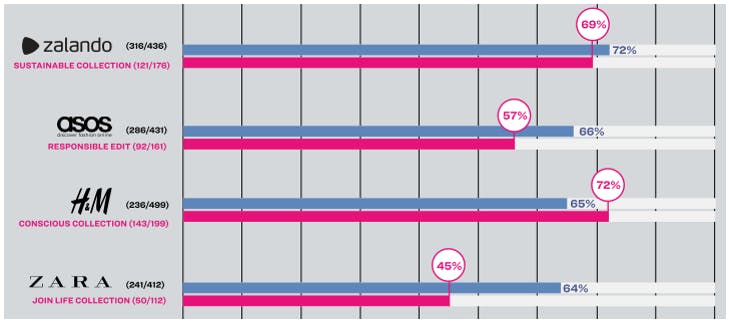From luxury brand Gucci to athleisure brand Lululemon, fashion’s “addiction” to synthetic fibres — which are derived from fossil fuels — has rendered 59 per cent of its sustainability claims invalid or misleading, found a report published by London-based Changing Markets Foundation on Wednesday. Only 38 per cent of these sustainability claims were verified by a third-party scheme or organisation.
To continue reading, subscribe to Eco‑Business.
There's something for everyone. We offer a range of subscription plans.
- Access our stories and receive our Insights Weekly newsletter with the free EB Member plan.
- Unlock unlimited access to our content and archive with EB Circle.
- Publish your content with EB Premium.
Valued at US$3 trillion, the global fashion industry produces up to 2.1 billion tonnes of CO2 a year, according to Global Fashion Agenda, a forum that advocates for sustainability in fashion and McKinsey & Company, a consultancy. This is approximately equivalent to the combined total annual emissions of France, Germany and Britain.
As consumers increasingly prioritise sustainability when making purchase decisions, major brands have taken some climate action measures. Swedish high-street retailer, H&M and department store, Target Australia are among the brands that recently backed an initiative to facilitate a circular fashion system by working with manufacturers in Bangladesh to reduce textile waste and increase the use of recycled fibres.
But some of these companies have repeatedly come under fire for greenwashing and unethical practices. H&M cut ties with its Chinese supplier last year, over accusations of “forced labour” involving ethnic and religious minorities from China’s Xinjiang province.
Not so ‘sustainable’ collections
Reviewing the policies and practices involving synthetic-fibre use by 46 apparel companies, Changing Markets Foundation revealed that the majority of clothes produced by fast fashion giants H&M, online retailer ASOS and British retailer, Marks & Spencer that are labelled “sustainable” and “sustainably made” flout the UK Competition and Markets Authority’s new guidelines on green claims in some way.
A pair of ASOS’s monomaterial “100 per cent nylon” female trousers were found to be made from 54 per cent nylon and 46 per cent polyester upon further inspection. The product was also described as “designed to be remade, so it’s easier to recycle when you’re done with it”. The report found this claim to be “highly misleading, especially given the lack of fibre-to-fibre recycling technology and the absence of any takeback scheme”.
Patagonia, an outdoor clothing brand well known for its sustainability ethos, was “red-zoned” in the report due to “minimum-to-no transparency about their use of synthetic fibres and/or that failed to engage with the issue entirely”. This is despite the brand’s aim to eventually move away from using virgin petroleum-based synthetic fibres like polyester and nylon, according to its website.
Across the four brands—Zalando, ASOS, H&M and Zara—with dedicated “sustainable”, “conscious” or “responsible” collections, synthetic materials — especially polyester — remain extensively used in these collections.

Number and percentage of products that contained synthetics for brands with “sustainable” collections; overall percentage of products shown in blue, percentage of products in “sustainable” collections shown in pink. Source: Changing Markets Foundation
H&M’s Conscious Collection contained a higher percentage of synthetics (72 per cent) than its main collection (61 per cent), while Zalando’s Join Life Collection used more polyester per item of clothing than its main collection.
Considering the devastating environmental impacts of synthetic fibre production, the report expressed concern over the numerous “vague and misleading” sustainability claims and how products were labelled as “recyclable” without any technology in place to actually recycle them back into clothes.
Downcycling: The trend
Changing Markets further determined that 85 per cent of companies reviewed touted the downcycling of polyethylene terephthalate (PET) bottles into recycled polyester for clothes-making as a panacea for the millions of tonnes of textile waste generated annually.
Downcycling is at most a stop-gap solution to the fashion waste crisis because it doesn’t address the emissions and harmful by-products of producing these PET bottles in the first place, according to the Plastic Pollution Coalition.
In contrast, fibre-to-fibre recycling, a more circular and sustainable way to incorporate recycled and recyclable materials in clothing, and the issue of microplastics affecting human health was largely ignored by the brands reviewed in the report.
Legally-borne responsibilities
Changing Markets called for the European Commission to implement mandatory measures to aid in dismantling the inherently unsustainable fast-fashion model. Specific recommendations include a tax on virgin plastic, setting up Extended Producer Responsibility (EPR) schemes for different types of textiles, and preventing companies from making unsubstantiated green claims.
Both the Commission and its US counterpart, the Federal Trade Commision (FTC), have taken steps in these directions. Hopefully, with the growing traction of sustainable fashion among consumers and within the industry, climate action will be taken more seriously than the next hot summer trend.








